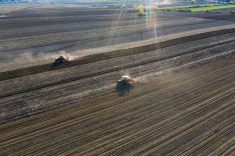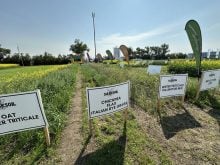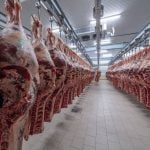Over the past 40 years, Prairie farmers have made extraordinary strides in improving soil quality. Two major reasons were the shift from using summerfallow to continuous cropping, and the shift from conventional cultivation to no-till or minimum-till farming.
Farmer adoption of these improved practices was gradual. Most famers were cautious and wanted to be sure new practices would be successful. Summerfallow acreage across the Prairies dropped from about 23 million acres in 1980 to about two million acres in 2020. In 1980, very little Prairie annual cropland was in no-till cropping. By 2020, over 75 per cent of annual cropland in Alberta and Saskatchewan was in no-till cropping. In Manitoba, only about 25 per cent of land was in no-till due to challenges such as dealing with surface residue.
Farmers realized the many advantages to reduced summerfallow and no-till cropping, which included:
Read Also

Claas brings 1000 Series SP forage harvesters to Canada
In mid-August, Claas unveiled its new line of Jaguar forage harvesters at an event in Visalia, California, deep in the heart of that state’s dairy region.
- better seedbed soil moisture for good spring germination;
- improved surface granular soil structure, and reduced soil crusting;
- gradual increase in soil organic matter (SOM) and soil quality;
- improved water infiltration and stored soil water;
- reduced water flow from fields; and
- greatly reduced wind erosion risk.
Elimination of summerfallow also led to reduced concerns with spread of secondary soil salinity.
Also, fields could be seeded earlier, which often resulted in increased crop yields, and all land on the farm is cropped, which increased farm profitability.
Elimination of tillage reduced plow layer soil compaction concerns, and there were significant savings in fuel and labour costs with reduced passes in the field.
These benefits often meant overall increased crop production on farm, improved soil quality, increased soil productivity, reduced soil erosion risks and reduced concerns with soil salinity.
Soil quality and soil health
One of the best articles I have read on soil health, by Henry Janzen et al (2021), is available online. It is well worth your time to review.
The terms ‘soil quality’ and ‘soil health’ are often used interchangeably. Farmers tend to use the term ‘soil health,’ which indicates soil as a living, dynamic organism. Descriptive properties are used to subjectively measure soil health.
Soil scientists tend to prefer the term ‘soil quality,’ which describes and measures quantifiable physical, chemical and biological characteristics. Soil scientists tend to look at ‘soil health’ as subjective judgements that are difficult to quantify or measure.
There are many definitions of soil quality. One I prefer is “the fitness of a specific kind of soil, to function within its capacity and within natural or managed ecosystem boundaries, to sustain plant and animal productivity, maintain or enhance water and air quality, and support human health and habitation (Karlen et al. 1997, Arshad and Martin 2002).”
The U.S. Department of Agriculture’s 2015 document on soil quality indicators (online here) states “the quality of a soil, or its capacity to function, is evaluated using inherent and dynamic soil properties. These properties serve as indicators of soil function and quality.”
Inherent soil properties change very little or not at all with farm management. Inherent soil properties form over thousands of years and result primarily from the soil forming factors: climate, topography, parent material, biota and time. Examples of inherent properties are soil texture, type of clay, depth of surface soil, depth to bedrock and internal drainage.
Dynamic, or management-dependent, soil properties are affected by farm management and natural disturbances over the human time scale. Changes in dynamic soil properties can occur in a single year or over several growing seasons. Soil indicators can be divided into physical, chemical and biological categories. depending on how they affect soil function. These categories are not always clearly defined as a soil property or indicator but can affect multiple soil functions.
Over the past several years, there has been increased discussion as to how to measure and evaluate soil quality or soil health. It is important to keep in mind that soil health cannot be measured directly. You cannot simply send a soil sample to a laboratory for some chemical analyses to fully determine soil health. Soil analysis to determine nutrient levels, salt levels (electrical conductivity), soil organic matter level or soil pH are very helpful, but do not give a full picture of soil health. Further, soil health cannot be determined simply by measuring crop yield. Soil quality must be evaluated and assessed using a number of indicators and soil properties.
‘Indicators’ refers to various properties of soil and crops that are assessed to provide information about how well soil can function. Indicators assess physical, chemical and biological properties of soil, and characteristics of soils.
Two useful documents to review for detailed information on soil quality assessment are:
- the Alberta Soil Quality Card (Agdex 525-2, 2003), and
- the Crop Land In-Field Soil Health Assessment Guide (USDA Technical Note No. 450-06, 2020).
Alberta Soil Quality Assessment Card
About 20 years ago, Alberta Agriculture developed a simple soil quality assessment card. It doesn’t use any soil analysis; it’s simply a scorecard to visually rate soils in each of your fields. The table you see here shows each indicator, with the corresponding ranking assessment. Keep in mind, this visual assessment is subjective and therefore has its limitations. This card is a simple assessment but is a good place to start to develop a better understanding of the quality of the soils in your fields.

Crop Land In-Field Soil Health Assessment Guide
USDA’s guide is a more rigorous assessment tool and is well worth your time to review.
Briefly, the following soil indicators are assessed. You’ll want to look at the USDA publication for more detailed information on how to assess each indicator.
Soil cover is a significant factor in promoting soil quality. That means keeping the soil surface covered, particularly during intercrop periods and prior to canopy closure. To assess, estimate the percent of the soil surface covered with dead plant material, organic mulch and live plant matter.
Residue breakdown is the biological cycling and decomposition of previous crop residue. The rate of residue decomposition can be an indicator of management-influenced biological activity. Breakdown is dependent on management, weather, climate, and soil and crop type.
Surface crusting and ponding/infiltration: Standing water, or evidence of surface water runoff from the soil, resulting from poor infiltration can be an indication of poor aggregate stability, crusting, lack of protective cover, poor soil structure, and/or compaction — which may lead to runoff, erosion and crop damage. Determine if crusts are present throughout the field, or only in patches.
Penetration resistance: Soil compaction can result from repeated wheel traffic, or repeated tillage at the same depth. Compaction inhibits water and gas movement through the soil and interferes with root growth and soil organism habitat, nutrient cycling, plant productivity and health. Penetration resistance increases as soils dry.
Water-stable aggregates: The stability of soil aggregates in the presence of water is important for water infiltration and storage, air exchange, plant root growth, soil organism habitat, protecting soil organic matter, decreased soil erodibility, nutrient cycling, plant productivity and health, as well as water quality and flooding. This indicator overlaps and is tied to many other resource concerns.
Soil structure affects water infiltration, impacting flooding and gas exchange, plant rooting, nutrient cycling, plant condition and health and soil organism habitat.
Soil colour can be used as an indicator of loss or accumulation of SOM, which influences most aspects of soil function, with higher SOM contents improving soil function. Typically, loss of SOM results in a lighter colour, with accumulation resulting in darker colours. Soil colour can be indicative of different soil mineralogy as well as organic matter.
Plant roots exude simple and complex carbohydrates that provide food and habitat to the microbial communities, which in turn build soil structure by forming soil aggregates. Root channels can remain from season to season and function as areas of carbon concentration and biological activity, improve infiltration and contribute to the ability of the soil to store water, reduce soil erosion and create pathways for gas exchange after senescence.
Biological diversity: Soil organisms influence all aspects of soil function including aggregation, water dynamics, nutrient cycling and pest suppression.
Biopores: Plant roots, earthworms and other macrofauna leave behind large pores called biopores. These are important for rapid air and water exchange. They provide additional access to water and nutrient resources for improved plant health and productivity. In addition, earthworm channels tend to be enriched in organic matter, microbes and nutrients, which assist nutrient cycling. Old biopores provide excellent pathways for newly established roots and soil biology movement corridors.
For each indicator, the USDA publication provides guidelines for assessment, which are well worth reviewing, to assist with reviewing the quality and health of the soils on your farm.
Regardless of the term you prefer — soil health or soil quality — well managed soils are critically important to long-term sustainable agriculture in Western Canada.















